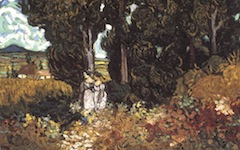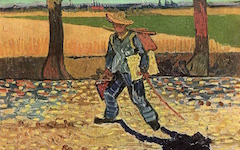Van Gogh’s Portrait of Eugene Bloch (1888)
Van Gogh once said that Eugene Bloch’s face reminded him of Dante which is why, according to Heather McPherson, his portrait by Van Gogh is today known as The Poet.1

Van Gogh, The Poet or Portrait of Eugene Bloch (1888) Oil on canvas. Musée d'Orsay, Paris.
Click image to enlarge.
Frankly I don’t see much resemblance between Bloch’s face, as portrayed by Van Gogh, and Dante’s though they both had large noses. Katherine Sachs has a different idea. Based on a letter from Vincent to Theo she believes that Bloch's portrait represents "The Artist."2
Click next thumbnail
Sachs is certainly correct because, unknown even to her, Bloch resembles Van Gogh: similar nose, similar moustache, both blond. Nevertheless, whether artist or poet, true artists think of themselves as part of a continuum of poetic minds. Van Gogh described himself as "a link in the chain of artists" that began, as George Shackleford remarked, "in the past and would extend beyond his present to the future of painting."3
See conclusion below
An artist's identification with other artists and other poets is so important that the viewer needs to keep an eye out for any visual reference to an earlier artist. Why, for instance, does Van Gogh's nose change from one self-portrait to another? Perhaps he was fusing his own nose with Rembrandt's or Millet's or even Dante's. In art anything is possible, as long as it has meaning. You just need to know what to look for.
More Works by Van Gogh
Van Gogh is one of the few artists whose hidden elements revealed on EPPH confirm the conventional view of his art.

Van Gogh’s Cypresses with Two Female Figures (1889)
Notes:
1. Heather McPherson, The Modern Portrait in Nineteenth-Century France(Cambridge University Press) 2001, pp. 10-11
2. Katherine Sachs, "Arles, February 1888 to April 1889: Chronology" in Van Gogh Face to Face: The Portraits (Detroit Institute of Arts) 2000, p. 130
3. George Shackleford, "Van Gogh in Paris: Between the Past and the Future" in Van Gogh Face to Face, p. 125
Original Publication Date on EPPH: 20 Apr 2010. | Updated: 0. © Simon Abrahams. Articles on this site are the copyright of Simon Abrahams. To use copyrighted material in print or other media for purposes beyond 'fair use', you must obtain permission from the copyright owner. Websites may link to this page without permission (please do) but may not reproduce the material on their own site without crediting Simon Abrahams and EPPH.



